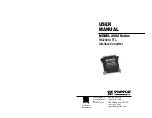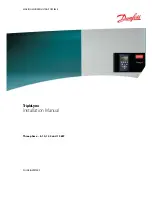
Electric Q1a Operation Manual Rev 4.1.2
5/24
24 August 2006
Automatic Features
Quantum features
4
are automatically controlled as a function of the directional state of the locomotive as described in the table below.
Feature Forward
Neutral
from
Forward Reverse Neutral
from
Reverse
Headlight
Bright Dim Dim Dim
Reverse Light
Dim
5
Dim Bright Dim
Mars Light
Strobing
Steady On
Steady On
Steady On
Ditch Lights
On
Off
Off
Off
Number Board Lights
On On On On
Marker Lights
On On On On
Cab Lights
Off after 15 seconds
On after 10 seconds.
Off after 15 seconds
On after 10 seconds.
Vents & Cooling Fans
On after 10 seconds
Off after 10 seconds
On after 10 seconds
Off after 10 seconds
Note: If your locomotive has a Mars Light, the Headlight will be off instead of “Dim” in all states except Forward where it will be Bright.
Neutral
In Neutral, the locomotive will continue to make prototypical sounds appropriate to its resting state.
•
Enter Neutral by turning the throttle down below V-Start but not off and wait for the locomotive to stop
6
. The Headlight and optional
Ditch Lights will turn off and the optional Mars Light switches to steady-on. The Reverse Light will turn off when entering Neutral.
•
You will hear a Short Air Let-off when the locomotive stops moving and enters Neutral, a Long Air Let-off about three seconds later,
followed by Air Pumps and other background sounds. After ten seconds the Electric Traction Motor Cooling Fans shut off if they were
on when you entered Neutral. Optional Cab Lights come on 10 seconds after entering Neutral.
•
After the Air Pumps start, you can use the direction switch to blow the Horn or turn on or off the Bell (if enabled).
Changing the Locomotive’s Direction without Turning off the Sound
You can use the power pack’s direction switch while the locomotive is in Neutral to change the locomotive’s direction.
•
Put the locomotive in Neutral by bringing the throttle down below V-start and waiting for the locomotive to stop.
•
Flip the direction switch after you hear the Short Air Let-off but before you hear the Long Air Let-off followed by Air Pump sounds
turning on. During this short time (3 seconds) the Horn will not blow when you flip the direction switch.
•
Turn up the throttle anytime thereafter to operate the locomotive in the opposite direction.
If you have waited until the Air Pumps start in Neutral and now wish to change direction, you can either:
1.
Reduce the throttle to off, change the direction switch and turn the throttle back up to repower the locomotive or,
2.
Leave the locomotive in Neutral, flip the direction switch (the Horn will come on) and then turn up the throttle. When the locomotive
starts to move in the opposite direction, the Horn will stop automatically and then hoot one more time if the direction is Forward for a
total of two hoots. Or if the direction is Reverse, the Horn will hoot two more times for a total of three hoots
7
.
Note: To prevent the first Horn hoot from being too long, do not delay in turning up the throttle after you have flipped the direction switch.
3 The hold time for strobing Ditch Lights after the horn button is released can be set using CV 55.84.5. The setting of this CV applies to both Analog and DCC operation.
4 Not all features, or dim light capability, may be available in your particular locomotive model.
5 Most Quantum 1 and Q1a Reverse Lights cannot be dimmed; they only have bright and off settings. In these cases, “Dim” is equivalent to “Off”.
6 If Regulated Throttle Control is enabled it is important to wait until the locomotive stops on its own. The locomotive’s electronic Inertial Control will keep it moving even though
you have reduced the throttle far enough below V-Start to stop the locomotive. In your attempt to stop the locomotive, do not try to reduce the throttle so far that all sounds turn
off.
7 Standard US prototype railroad signaling is two hoots before starting in forward and three hoots before starting in reverse. Other countries have different signaling. Check your
Electric Model Specification sheet for horn sequences used on your model.






































